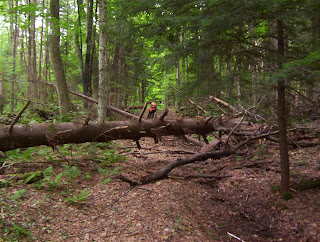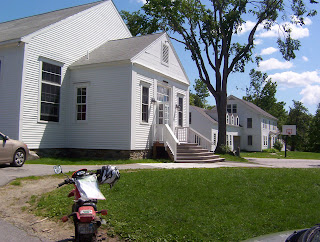If all went well, this would be the final day's ride-the last leg in the link between Massachusetts and Canada. It started well, great roads in Bridgewater, and then Barnard, until I stopped to read a posting that said the selectman had closed all class 4 roads in Barnard between Oct. 15 and Dec. 15*. This was Oct 21st. Of course, I had had no idea that this would happen and both the ride north and the return route south went through Barnard. No time to plan alternate routes, only enough to make the run up and back.
This would force me to leave my goal of staying on unimproved roads as much as possible. However, it just wasn't possible-not today in Barnard. To make it worse, there was no direct way to pick up the route on the other side of Barnard. The only choice was a long highway ride up route 12 north and east. And another long hiway ride west and south on route 107 to Stockbridge, where I picked up the pure water ride route again. I'd covered at least twice as many miles that were less than half as enjoyable, but at least it didn't take any longer.

The Barnard General Store has a large food counter and several chairs for eat-in dining. It seemed a popular spot for the locals (their cars are parked on the Rt 12 side of the building).
They also had AA batteries which I needed for my camera, which had gone dead since the last day's ride.
Except for the long highway slog, all day I enjoyed riding over a crisp carpet of leaves covering the lesser traveled back roads. The freshly fallen leaves looked great and the swishing sound brought back childhood memories of crunching along the sidewalks to and from school.

The last road to complete the ride was the Granville-Bridgewater Road - a fine old country road that winds its way steeply up from Granville through the Bridgewater Gap and then descends gradually and nearly straightly mile after mile down the east flank the mountain towards route 12. And so the final miles of the 2009 pure water ride were all down hill, easy going, and my mind was free to anticipate the completion and admire the mountains across the valley covered with yellow and orange.

On route 12 again I turned north and rode one tenth of a mile to the intersection that marked the southern most point of the previous day's ride and the non-descript end of the pure water ride. It was nothing as grand and satisfying as the day my wife and I rode (out of order) up to the Canadian border.
(As always, I made sure that I returned to the ending of the previous ride to insure that my route was continuous, even when it meant something as trivial as the tenth of a mile I had just ridden.)
The Pure Water Ride is now officially complete. So far a total of $585 has been donated to the two charities. Thank you, thank you, to those who have contributed. Because of you, many more people have healthy drinking water, but the need is still great. If you haven't already, please consider donating now.
* When I got home, I wrote to the Barnard Selectmen asking for permission to ride the class 4 roads during the restricted season. They responded that there was a change in the restricted dates to Dec. 15th through March 15th, and most signs were changed, but apparently the one I saw had been overlooked. Since the new dates would have no effect on future Pure Water Rides, I was OK with that.





































 From a US State Department report (
From a US State Department report (